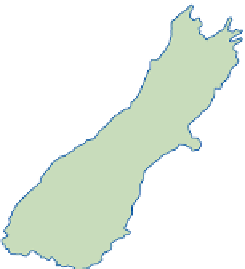Geoscience Reference
In-Depth Information
Distance (miles)
0
25
50
7
5
450
NW
SE
1100
400
1000
900
350
800
300
700
0
200
250
600
km
200
500
400
150
300
100
3000
metres
feet
8000
6000
4000
2000
200
2000
100
1000
0
0
0
10
20
30
40
50 60
Distance (km)
70
80
90
100
110
Figure 5.15
Mean annual precipitation (1951-1980) along a transect of the South Island of New Zealand,
shown as the solid line in the inset map. On the latter, the dashed line indicates the position of the Godzone
Wetzone and the figures give the precipitation peaks (cm) at three locations along the Godzone Wetzone.
Sources: Chinn (1979) and Henderson (1993), by permission of the New Zealand Alpine Club Inc. and T. J. Chinn.
processes involved, Tor Bergeron proposed using
the term 'orogenic', rather than orographic,
precipitation, (i.e., an origin related to various
orographically produced effects). An extreme
example of orographic precipitation is found on
the western slope of the southern Alps of New
Zealand, where mean annual rainfall totals exceed
10 meters! (
Figure 5.15
).
In mid-latitude areas where precipitation is
predominantly of cyclonic origin, orographic
effects tend to increase both the frequency and
intensity of winter precipitation, whereas during
summer and in continental climates with a higher
condensation level the main effect of relief is the
occasional triggering of intense thunderstorm
type precipitation. The orographic influence
occurs only in the proximity of high ground in
the case of a stable atmosphere. Radar studies
show that the main effect in this case is one of
redistribution, whereas in the case of an unstable
atmosphere precipitation appears to be increased,
or at least redistributed on a larger scale, since the

























































